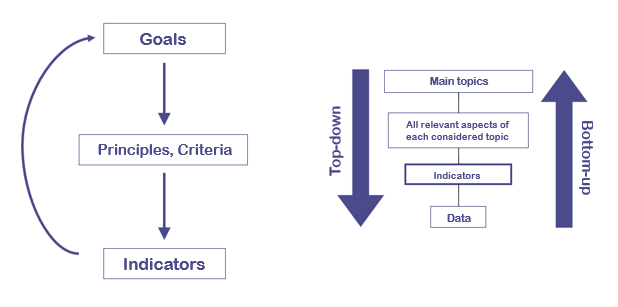Developing an indicator
The development of indicators is a fundamental step for supporting sustainable development. However, the existing indicators are mostly based on a top-down approach and can miss critical sustainable development issues at the local level. That is the reason why we need to combine the top-down approach with the bottom-up approach.
Through the combined procedure, we try to make sure that all of the affected stakeholders are involved… Don’t forget, they can be affected positive or negative!

Figure A
Figure B
When using the combined approach we can select indicators related to all for a complete analysis. It also allows you to identify the feasible indicators in terms of data availability. As it makes no sense to select an indicator that has no measured data and is not comparable.
Goal = a description of future condition community members wish to achieve
It provides a framework for developing indicators and the context for tracking, reporting, and discussing the indicators.
A good and sustainable goal:
– Reflects a balance between economic, social, and environmental conditions
– Recognizes and accounts for long-term limits of natural, social, and built systems
– Promotes inter- and intra-generational equity
– Reflects a ‘big picture’ system view
Principle = a rule of conduct
Criteria = factors by which we can judge something
Indicator = a numeric measure that provides key information about a system’s condition
As you have already learned in the lecture before, an indicator clarifies and specifies what the goal is and it monitors if we are moving towards or away from the goal
Or the so-called expert based approach (Figure B).
Here, experts start by identifying through research what is valuable to society. Based on their knowledge, indicators are selected, data is collected and assessed for relevance using statistical tools. This process exposes trends, that might be missed by a more casual observation.
A problem that can occur is, that there is no data for the selected indicator and the process has to be started again. Another weakness of this approach is that is often fails to engage the local communities.
This is the community bases approach (Figure B).
It emphasizes on local communities to establish priorities and set goals. This means that the approach comes more from social science, it includes cultural anthropology, social activism, education and social psychology. Ideally it is an on-going learning process between the community and the researches. The idea behind this approach is that you need to understand first the problems and needs of the locals, to be able to come up with solutions and innovations. A weakness of this approach is that it may not be able to monitor sustainability very accurate.
Reflection
How do we select and/or develop a set of indicators?
What is the difference between the bottom-up and top-down approach?
How would you describe a good sustainable goal?
